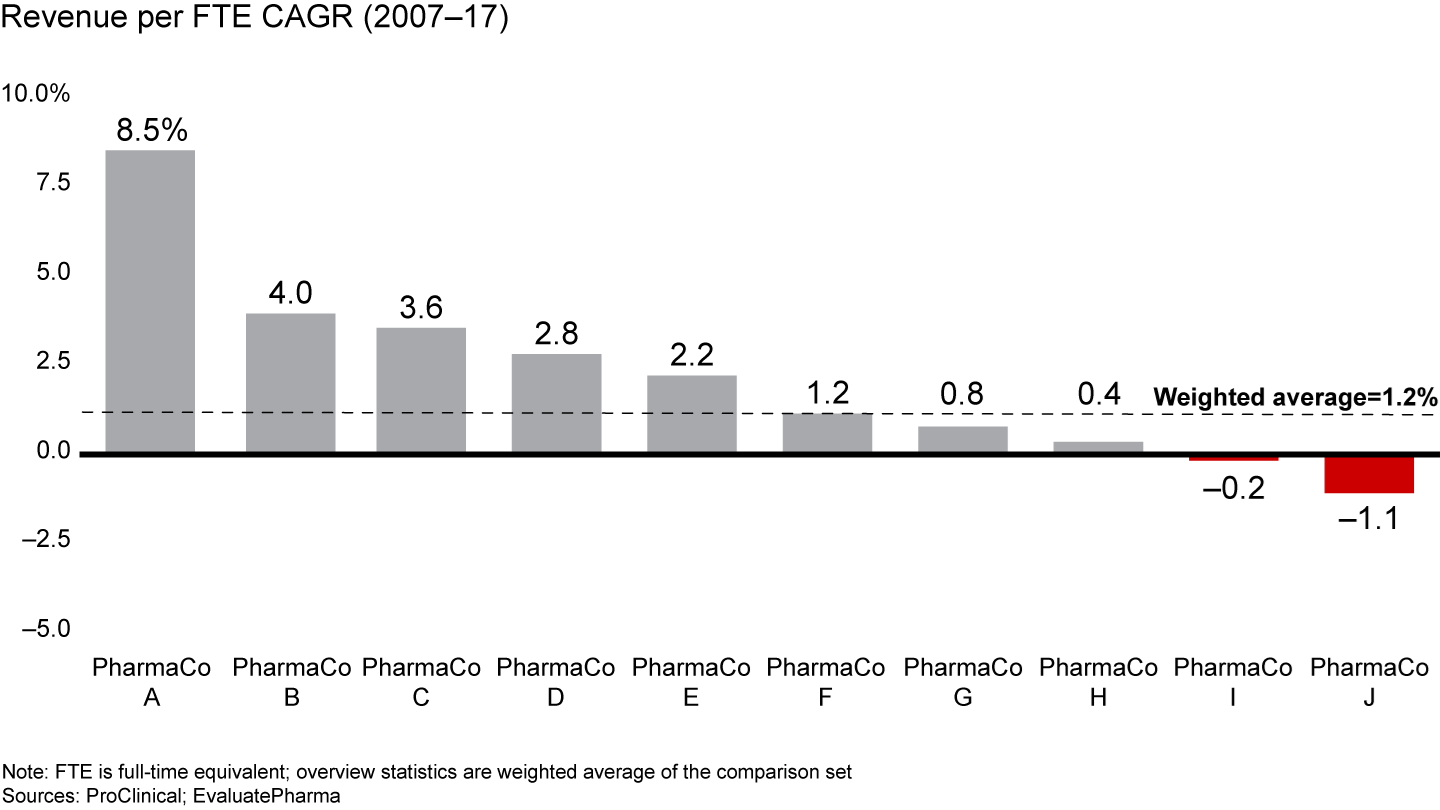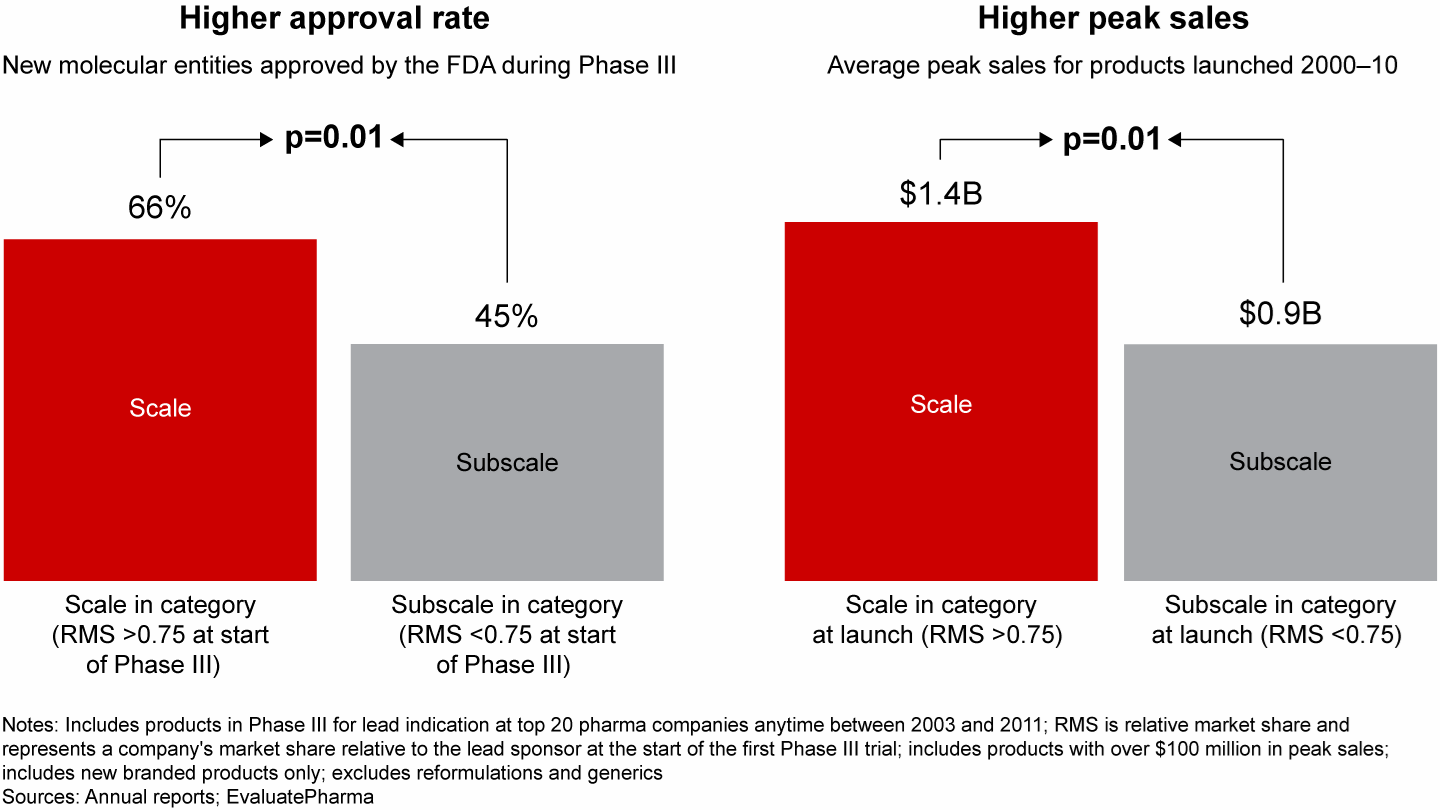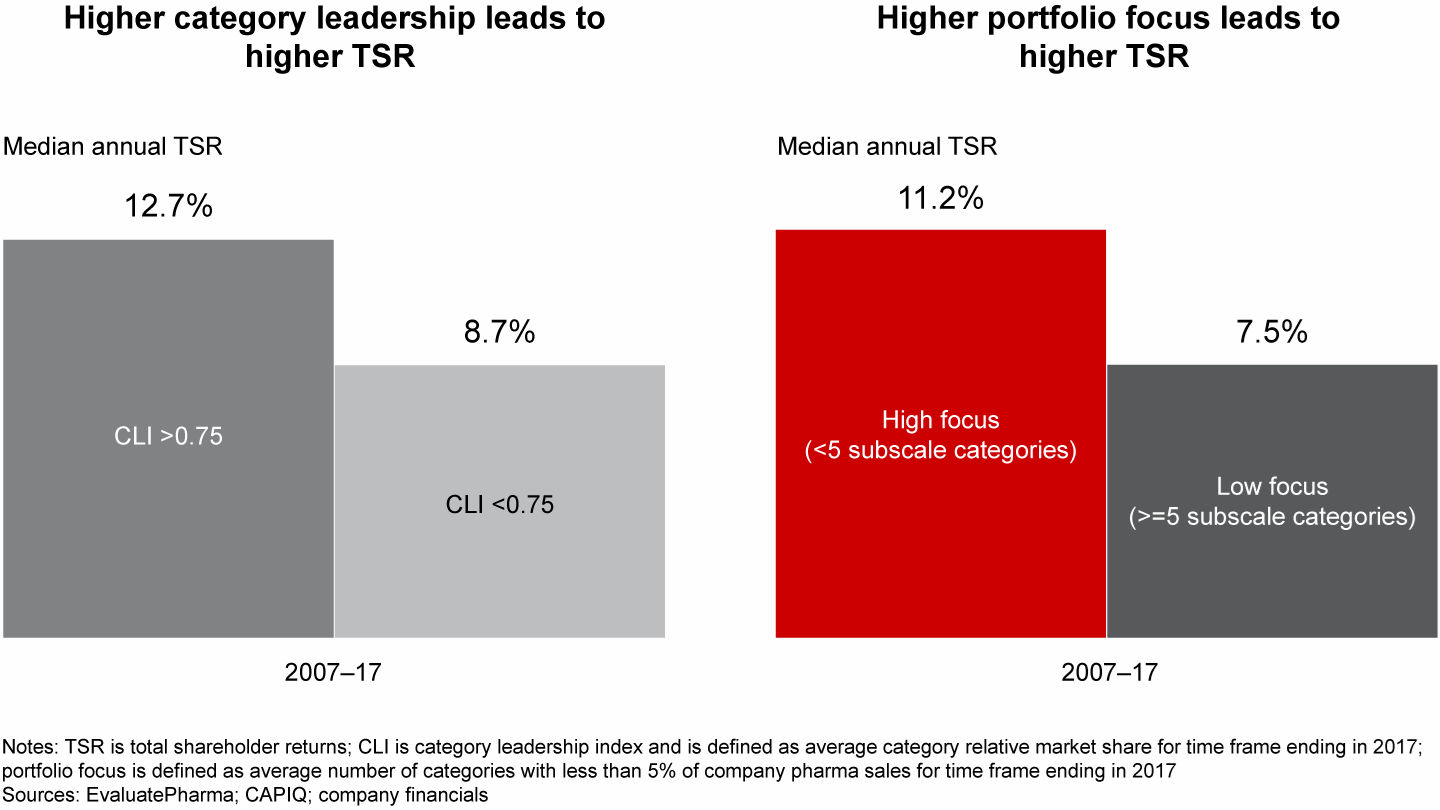Brief

Executive Summary
- Average employee productivity growth at pharma companies over the past 10 years is nearly flat.
- Leadership teams that rely on an incremental approach to performance improvement risk seeing market share erode and valuations drop.
- A few leaders are pulling ahead of the competition by pursuing category leadership, customer focus and lean operations.
Is single-digit growth and pressure on margins the new normal? Over the past three years the pharma industry stock market index has sharply underperformed the S&P 500. That abrupt deceleration has many leadership teams anxiously asking if the industry has reached a turning point. The answer is yes—and senior executives who have spent their careers managing heady expansion now face a huge challenge.
Escalating pricing pressure, fierce competition and higher innovation hurdles have dramatically changed the playing field. The average period of exclusivity on the market following a novel drug’s launch until a competitor enters the class has plummeted from eight years to four years. All of these forces are undercutting industry growth. At the same time, pharma companies have been unable to tame costs. The average employee productivity increase over the past 10 years at top pharma companies was only 1.2%. Stripping out price increases, productivity was flat—no gain at all from 2007 to 2017 (see Figure 1).
In that changed market dynamic, traditional pharma strategies no longer deliver the growth that investors and other stakeholders are expecting. But that’s no reason for leadership teams to set their sights lower. Even in an era of heated competition and slower expansion, companies can outrun rivals and win market share. A few successful leaders already are breaking away from the pack and rethinking their strategies—determined to grow faster than the rest of the industry.
Take the example of Ipsen, which delivered a 90% increase in revenues between 2010 and 2017 and a fivefold increase in market capitalization. The leadership team outperformed the industry by reorganizing its business around four customer-oriented global franchises, transforming Ipsen from a broadbased European primary care company to a focused global specialty drug company. They built leadership positions in a few core businesses including oncology, expanded Ipsen’s presence in the US and exited high-risk biotech partnerships.
Ipsen’s strategy to narrow its focus and lead in a few key franchises created a virtuous circle. Greater management attention on fewer businesses gave the company a better understanding of its most critical customers. It also helped streamline global operations, freeing up cash and management time to invest in further advancing its core businesses. Importantly, Ipsen’s leadership positions helped the company win attractive business development deals.
Average productivity growth at major pharma companies has been nearly flat over the past 10 years


In our experience, pharma companies that build a strategy around these three components—category leadership in a few product areas, customer-focus and lean operations—position themselves for growth that far outstrips the industry average. No question, each of these efforts alone generates benefits, but most companies fall short of achieving their full potential individually—and combining all three has the most powerful impact on growth and value creation.
In fact, category leadership, customer focus and lean operating models reinforce one another, and help pharma companies navigate change. Instead of targeting new technologies as the sole priority, category leaders focus on the solutions customers want and build a franchise around them. That customer-oriented approach generates growth more effectively and builds sustainable advantage. It also helps streamline operations by pruning businesses and research where a company is not able to develop leading positions or generate customer value. That, in turn, frees up cash to invest in advancing leadership positions.
Build category leadership
Category leadership can transform a pharma company’s performance. It produces deep customer knowledge and commercial clout that allows leadership teams to reshape the categories they compete in by introducing new business models, such as value-added services and alternative pricing models. Category leaders know more about the needs of the customer groups that use their products and have privileged insight into the perspectives of key opinion leaders and other stakeholders. They also have a superior ability to gather real-world evidence and aggregate data in support of efficacy claims. That creates greater customer engagement and superior insights. Thanks to all those strengths, category leaders have better brand recognition, deeper clinical expertise and more relevant products.
Bain research shows portfolio focus at the core of a category leadership strategy leads to superior value creation. Overall, category leaders deliver better average returns because they have more successful launches, produce higher peak sales and reach those peaks faster than rivals (see Figure 2). But to reap the full benefits of category leadership, pharma companies need to divest follower businesses that drag down shareholder returns. Over 10 years, companies with high portfolio focus generate median shareholder returns of 11.2% compared with 7.5% for companies with low portfolio focus (see Figure 3).
Of course, transforming a broadly diversified pharma company requires time and investment, in particular to win competitive merger and acquisition (M&A) deals. (Nearly 70% of all revenue at pharma companies with the highest total shareholder returns comes from acquisitions.) While moving down this path, leadership teams can create value and resources for the future by refocusing their entire organization on customers’ needs and shifting to a lean operating model.
Category leaders have greater success launching products in late-stage development


Category leadership and portfolio focus in pharma strongly influence total shareholder returns


Create a customer-focused organization
Many pharma companies still place bets across a broadly diversified portfolio. They continue to rely on a resource-heavy push model in which explaining the differences in product profiles to healthcare providers is the default priority for all commercial campaigns. Some companies still allocate up to 80% of commercial resources to this activity. However, Bain research shows only 50% of the success of the typical competitive pharma product is determined by its product features or clinical profile. The other half of the success is related to how a company serves its customers’ needs.
Identifying the solutions that customers value most helps pharma companies deliver stronger topline growth, both for existing products and new launches. Winners invest in the customer groups and customer episodes that matter most, instead of addressing all the needs of every customer. Companies that excel at managing the customer experience and building customer advocacy can increase their market capitalization by 25% or more. The added benefit of this targeted approach is the elimination of low-value activities that create added cost and complexity.
Excelling at customer focus requires organizations to significantly reallocate resources. Instead of spending the bulk of commercial resources on promoting products to healthcare professionals, they invest in vital new capabilities such as digital tools, real-world evidence and data—all critical to the next growth model.
Leaders break down organizational silos that hinder communication and elevate the role of cross-functional teams. That improves collaboration between commercial, medical and development functions and helps them develop solutions that delight customers. Putting the cross-functional perspective first, and function second, improves efficiency. Multifunctional teams can incorporate regulatory and compliance functions in their solutions, for example, instead of allowing them to become an impediment to change. Elevating the role of cross-functional teams has far-reaching implications for incentives and talent development.
Switch to a lean operating model
Pharma companies can achieve major productivity gains by going lean. Bain research shows pharma general and administrative support functions operate less efficiently on average than those in other technology or capital-intensive industries. Average finance costs as a percent of revenue, for example, are 40% higher than in other industries. Pharma companies also have more organizational layers than other industries have.
Pharma cost-reduction programs often fail because they rely on incremental improvement instead of bold redesigns. Leadership teams typically benchmark themselves against other pharma competitors, instead of champions in other industries that are achieving much more dramatic cost improvements. In our experience, few pharma companies have succeeded in recent years at actually lowering their costs. Many companies also overlook the need to change underlying behaviors and invest in the capabilities and infrastructure to lock in savings and manage spending effectively.
The industry doesn’t have to look far for solutions: Leading companies in many industries achieve significant cost improvement with new tools that pharma has been slower to adopt, including zero-based budgeting and zero-based redesign. This blank-sheet approach simplifies organizations and reduces costs by redefining a company’s operating model and service levels.
Changing behaviors is the secret to building a lean operating model. Successful companies create a culture of cost efficiency in addition to implementing a onetime cost reset. Pharma companies that embrace significant structural and behavioral change can produce a 5- to 10-point margin improvement without affecting underlying business performance. Amgen, for example, used a transformation program to reduce overall costs by $1.5 billion, more than 14% of the entire company cost base. Companies that get it right not only lower cost and increase productivity; they create higher employee engagement and improve talent retention.
A rising tide once raised all boats in the pharma industry. The new reality is a fiercely competitive market where leaders win at the expense of others. In the coming decade, only those companies that outperform the industry will be able to fund the mergers and acquisitions required to stay on top. Leadership teams that rely on traditional performance improvement strategies risk seeing their market share erode and valuations drop, making them prime M&A targets. Indeed, consolidation has begun accelerating. Pharma companies that up their game in category leadership, customer focus and cost productivity will be well positioned to break out of the pack and help lead industry consolidation—instead of becoming a target of faster-growing rivals.
Nils Behnke is a partner with Bain & Company in the San Francisco office. Jason Evers is a partner in Bain’s Chicago office. Pete Hultman and George Eliades are Bain partners in the firm’s San Francisco office.